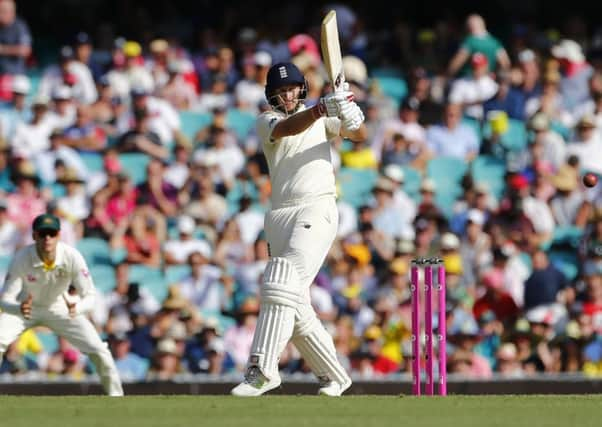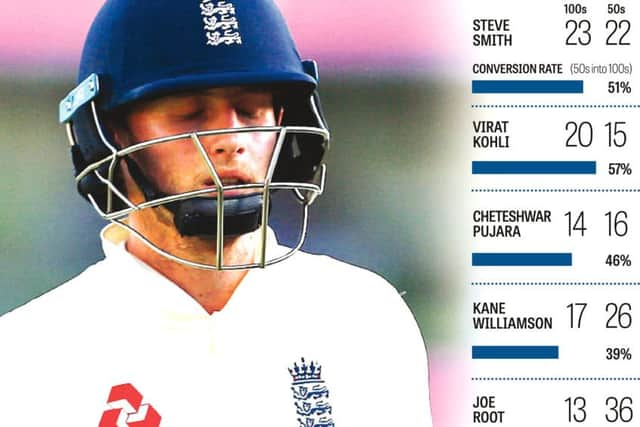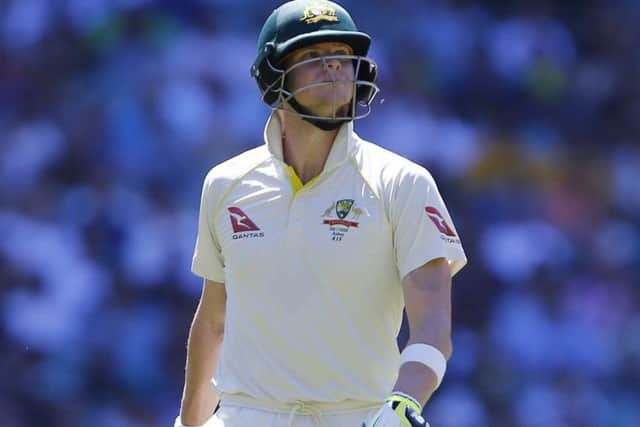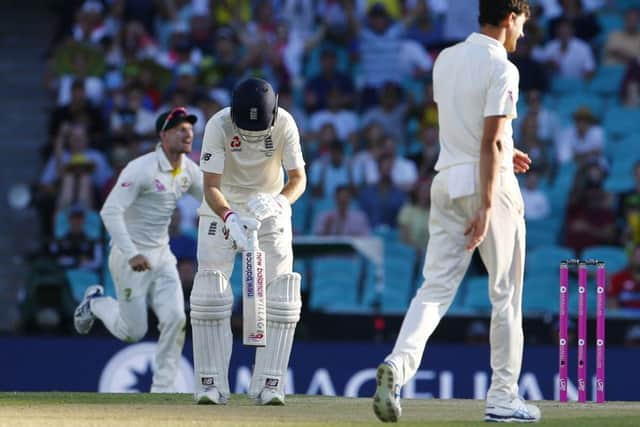Chris Waters '“ The Ashes: Time for Root to get tough on himself in order to match Test peers


On the face of it, it is not a bad problem to have: a bit like a striker who invariably scores one or two goals in a football match but only infrequently nets a hat-trick.
But try telling that to Root, who fell for 83 on day one of the fifth and final Test in Sydney with a hundred once more there for the taking.
Advertisement
Hide AdAdvertisement
Hide AdIt was his fourth half-century of the series and his highest score of the rubber, and it left him having converted only two of his last 15 fifties into three-figure scores.
As England made 233-5 after Root won the toss, the captain continued his remarkable record, first of all, of hardly ever failing.
Indeed, beginning with his 254 against Pakistan at Old Trafford in 2016, when he converted in excelsis by making his highest Test score, Root has reached fifty in 20 of his last 40 Test innings, an exceptional level of consistency.
Single-figure scores by the Yorkshireman have been few and far between, while Root has gone 46 innings without registering a Test duck, his last against Sri Lanka at Headingley in May 2016.
Advertisement
Hide AdAdvertisement
Hide AdBut, outstanding player though he is, Root has turned only 13 of his 49 Test fifties into hundreds, his problems with conversion now sufficiently concerning that the best remedy might almost be to take a walk down the road to Damascus.


The problem is exacerbated, of course, by the performances of his peers.
Root is the fifth-highest ranked batsman in world cricket, behind only Steve Smith, Virat Kohli, Cheteshwar Pujara and Kane Williamson.
But whereas Root converts only 26 per cent of his fifties into three-figure scores, Kohli’s conversion rate is 57 per cent, Smith’s 51, Pujara’s 46 and Williamson’s 39.
Advertisement
Hide AdAdvertisement
Hide AdOn average, Root scores a hundred once every nine innings – again, not a flimsy return for a good Test player, but Root has proved himself unequivocally to be better than simply “good”.


None of which will be news to the man himself.
“To not go on and make those big scores that as a senior player you pride yourself doing in big series, and which I have done in the past, is disappointing,” he said prior to the Sydney Test, adding that there is “no exact science” to scoring more hundreds.
Similar sentiments were echoed last night by England assistant coach Paul Farbrace, who had just watched the tourists lose Root to a clipped catch to Mitchell Marsh at square-leg off Mitchell Starc and Jonny Bairstow to a catch behind off Josh Hazlewood in the dying stages to the second new ball.
“To see Rooty get out the way he did, he’s incredibly disappointed and frustrated,” said Farbrace.


“He knows he wants to convert more 50s into 100s.
Advertisement
Hide AdAdvertisement
Hide Ad“It’s not something any coach needs to sit him down and say, ‘do you realise you need to convert more fifties?’”
According to Nasser Hussain, the former England captain, Root needs to be harder on himself.
He believes the Yorkshireman’s legacy could even depend on it.
“The greatest batsmen – guys like Virat Kohli and Steve Smith – have excellent conversion rates,” said Hussain.
Advertisement
Hide AdAdvertisement
Hide Ad“They grasp the simple fact that you don’t win Tests with pretty 50s and 60s. You win them with big hundreds or even doubles.


“At some point, Root is going to have to sit down and ask himself whether he’s working out those percentages properly.
“He’s got all the shots in the world, but if he wants to be remembered as one of the greats – and he has the talent – then he’ll need to be harder on himself.”
Root’s difficulties are especially highlighted, of course, by the performance of Steve Smith in this series, which has been the biggest difference between the sides.
Advertisement
Hide AdAdvertisement
Hide AdIf Smith bags a pair in the current Test – and there would seem about as much chance of that happening as Sydney Harbour Bridge suddenly vanishing into thin air – he would still finish with a series average over 100.
Confessing to a twinge of jealousy prior to the game, Root conceded that Smith had delivered a lesson in how to lead from the front.
“You see that (Smith’s run-scoring) and you want to be the one doing it,” he said.
“It’s a little lesson to me on leading from the front and how he’s played different types of innings at different periods of games.”
Advertisement
Hide AdAdvertisement
Hide AdIt is an unfortunate by-product of talent that the particularly talented such as Root are judged by standards which, were they achieved by lesser mortals, would be celebrated with unfettered delight.
When a man’s biggest difficulty is that he cannot stop scoring half-centuries, he can at least console himself with the thought that it is the cricketing equivalent of a First World problem, and, however infuriating it might be, it is one that many other players would dearly love to have.